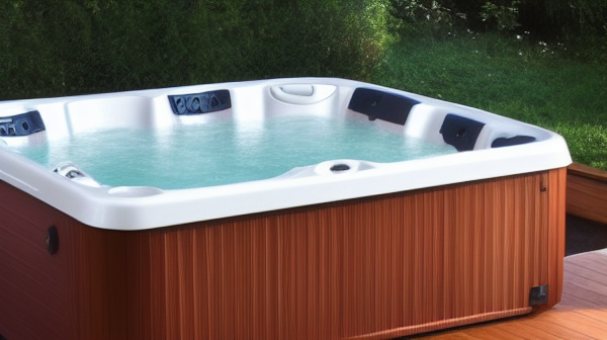Sink into relaxation and stay safe with our essential hot tub safety tips – the perfect guide for a worry-free soak.
Are you concerned about how to ensure a safe and enjoyable hot tub experience? Look no further! In this comprehensive article on hot tub safety, we will address the key measures you need to take to protect yourself and your loved ones while indulging in the soothing waters of your hot tub.
So, let’s dive in and explore the important aspects of hot tub safety that will give you peace of mind throughout your rejuvenating soak.
IN THIS ARTICLE
Importance of Hot Tub Safety
Hot tubs offer a luxurious and relaxing experience, but it’s crucial to prioritize safety while enjoying them. By following proper precautions, you can ensure a worry-free soak that leaves you refreshed and rejuvenated. Let’s delve into the importance of hot tub safety and explore some key guidelines to keep in mind.
Temperature Control and Hygiene
Maintaining appropriate water temperature is essential for hot tub safety. The recommended temperature range is typically between 100°F to 104°F (37°C to 40°C), which strikes a balance between comfort and preventing overheating or fainting.
Furthermore, maintaining clean, sanitized water is vital to prevent bacterial growth and potential infections. Regularly test the water quality using a reliable kit that measures chlorine levels, pH balance, and alkalinity.
Read more about how long you should stay in a hot tub.
Limited Soaking Time
While soaking in hot water can be tempting for extended periods, it’s important to practice moderation. Prolonged exposure may lead to dehydration or overheating, so limit your soaking time to around 15-30 minutes per session. Take regular breaks outside the hot tub to cool down and hydrate.
Slippery Surfaces
Hot tub areas can become slippery due to splashes or excess moisture. To prevent accidents like slips or falls:
- Ensure adequate lighting around the hot tub area.
- Use non-slip mats on walking surfaces.
- Install handrails for added support when entering or exiting the hot tub.
Taking these measures significantly reduces the risk of injuries caused by slippery conditions.
Benefits of a Relaxing and Secure Soak
While safety remains paramount when using hot tubs, it’s equally important to highlight the benefits they offer for relaxation and well-being. Here are some reasons why indulging in a secure soak can greatly enhance your overall experience:
Stress Relief
Immersing yourself in warm water creates a calming effect that aids in stress reduction. The combination of buoyancy and heat stimulates the body’s natural relaxation response, promoting tranquility and reducing anxiety levels.
Muscle Relaxation
Hot tubs provide hydrotherapy benefits by loosening tight muscles and easing tension throughout the body. Thiscan be particularly beneficial for individuals with muscle pain, stiffness, or sports-related injuries.
Improved Sleep Quality
The warm water and serene environment of a hot tub can help improve sleep quality. Soaking before bedtime raises the body’s temperature slightly, enhancing the ease of falling asleep naturally.
Social Bonding
Hot tubs serve as spaces for social interaction and bonding with friends and family. Sharing this relaxing experience together fosters connections and creates memorable moments.
Key Takeaways
Ensuring hot tub safety is not just responsible; it’s essential for creating an enjoyable experience. By adhering to temperature guidelines, practicing moderation, maintaining cleanliness, and taking precautions against slips and falls, you can fully enjoy the numerous benefits that hot tubs offer. So go ahead, immerse yourself in a secure soak, and embrace the ultimate relaxation that awaits you in those inviting bubbling waters.
Setting the Right Temperature
A hot tub’s temperature plays a significant role in maximizing your relaxation and ensuring safety. Let’s explore the optimal temperature range, risks of extreme temperatures, and how to adjust the temperature safely.
Watch on Youtube.com
Optimal Temperature Range for Hot Tubs
To achieve the perfect balance between comfort and safety, it’s important to maintain the optimal temperature range in your hot tub. The recommended temperature typically falls between 100°F to 104°F (37°C to 40°C). Within this range, you can enjoy a warm and soothing soak without risking overheating or discomfort.
Risks of Extreme Temperatures
Extreme temperatures in hot tubs can lead to various health risks. If the water is too hot, it can cause dizziness, nausea, fainting, or heatstroke. On the other hand, if the water is too cold, it may not provide the desired relaxation benefits and can result in shivering or discomfort.
Exposure to extreme temperatures can also put strain on your cardiovascular system. It’s crucial to avoid prolonged exposure to excessively hot or cold water as it can negatively impact your overall well-being.
How to Adjust the Temperature Safely
Adjusting the temperature of your hot tub should be done carefully to ensure both comfort and safety:
- Consult manufacturer guidelines: Refer to your hot tub’s manual for specific instructions on adjusting the temperature. Different models may have unique settings and controls.
- Gradual changes: Avoid drastic changes in temperature all at once. Instead, make gradual adjustments by increasing or decreasing it slowly over time until you reach your desired level of warmth.
- Monitor while adjusting: Keep an eye on any noticeable changes in water temperature while adjusting it. By monitoring closely during this process, you can prevent sudden surprises and maintain control over your experience.
Remember that individual preferences for hot tub temperatures may vary. What feels comfortable for one person might be too hot or cold for another. Prioritize your own comfort and well-being when setting the temperature, and always listen to your body’s cues.
Maintaining Hygiene and Cleanliness
Ensuring hygiene and cleanliness in your hot tub is essential for your health and overall enjoyment. Let’s delve into the importance of regular water maintenance, proper use of sanitizers and chemicals, as well as the significance of showering before using a hot tub.
Regular Water Maintenance
Keeping the water in your hot tub clean and balanced is crucial to prevent the growth of bacteria, algae, and other contaminants. Regular maintenance tasks include:
- Testing the water chemistry
- Adjusting pH levels
- Adding appropriate sanitizers
- Regularly replacing the water filter
By staying on top of these maintenance tasks, you can maintain clean and safe water for your hot tub.
Proper Use of Sanitizers and Chemicals
Sanitizers and chemicals play a vital role in maintaining sanitary conditions in your hot tub. Chlorine or bromine are commonly used sanitizers that help kill bacteria, viruses, and other harmful organisms in the water. It’s crucial to follow manufacturer guidelines regarding the proper dosage of sanitizers and chemicals to ensure effective sanitation without overusing them. Overuse of chemicals can lead to imbalanced water chemistry and potential skin or eye irritation.
Importance of Showering before Hot Tub Use
Showering before entering a hot tub might seem like an inconvenience, but it plays a significant role in maintaining water quality. Showering removes dirt, oils, lotions, sweat, and other bodily substances that can introduce contaminants into the hot tub water. By showering beforehand, you not only contribute to cleaner water but also reduce the risk of skin irritation or allergic reactions caused by these substances interacting with sanitizer chemicals.
Remember, maintaining hygiene and cleanliness in your hot tub is essential for your health and the longevity of your hot tub. Regular maintenance, proper use of sanitizers and chemicals, and showering before use are key practices to ensure a clean and enjoyable hot tub experience.
Essential Hot Tub Safety Measures
When it comes to enjoying your hot tub safely, there are several essential measures you should take. From installing a secure cover to setting time limits for soaking, let’s explore the key safety precautions you should practice.
Installing and Using a Secure Cover
To prevent accidents and unauthorized access, it’s crucial to install and use a secure cover on your hot tub when not in use. The cover will also help retain heat and keep debris out of the water.
Avoiding Alcohol Consumption
While it may be tempting to unwind with a drink while soaking in your hot tub, it’s important to avoid alcohol consumption. Alcohol can impair judgment, cause dehydration, increase the risk of overheating, and reduce coordination – all of which can lead to accidents or injuries.
Setting Time Limits for Soaking
It’s recommended to set time limits for each hot tub session. Prolonged exposure to high heat can cause dizziness, lightheadedness, or even heat stroke. Stick to 15-30 minute sessions and take breaks in between to regulate body temperature.
Supervision and Safety for Children
If children will be using the hot tub, close supervision is necessary at all times. They should never be left unattended in or around the hot tub area as they are more susceptible to overheating and accidents due to their smaller size and lesser tolerance for extreme temperatures.
Preventing Slip and Fall Accidents
To prevent slip and fall accidents around the hot tub area, consider implementing safety measures such as slip-resistant flooring or mats nearby. Additionally, ensure that there is proper lighting in and around the hot tub area for better visibility during nighttime use.
| Safety Measure | Description |
|---|---|
| Installing and Using a Secure Cover | Install a secure cover on the hot tub when not in use to prevent accidents, unauthorized access, retain heat, and keep debris out of the water. |
| Avoiding Alcohol Consumption | Refrain from consuming alcohol while using the hot tub as it can impair judgment, cause dehydration, increase the risk of overheating, and reduce coordination. |
| Setting Time Limits for Soaking | Limit each hot tub session to 15-30 minutes to prevent dizziness, lightheadedness, and heat-related issues. Take breaks in between to regulate body temperature. |
| Supervision and Safety for Children | Always supervise children using the hot tub and ensure they are not left unattended. Children are more susceptible to overheating and accidents due to their smaller size. |
| Preventing Slip and Fall Accidents | Implement safety measures such as slip-resistant flooring or mats around the hot tub area. Ensure proper lighting for better visibility, especially during nighttime use. |
Hot Tub Safety Rules Sign
Ensure safety in your hot tub with the high-quality and durable hot tub safety rules sign by Sigo Signs.
The hot tub safety rules sign by Sigo Signs is highly rated with an overall score of 4.8 out of 5 stars. Customers appreciate the high quality and durability of the sign, as well as its fade-resistant graphics. The pre-drilled holes make it easy to mount, and the size of the sign is designed to ensure clear visibility without being overwhelming.
- Made from high-quality, rust-free aluminum that is designed to last for many years.
- Fade-resistant graphics and wordings withstand various weather conditions.
- Pre-drilled holes for easy mounting on any surface.
- The sign’s size is carefully designed to make the wording stand out without being aggressive.
- Professional graphics create a sleek and authoritative appearance.
Handling Hot Tub Emergencies
Even with all the necessary safety precautions in place, emergencies can still occur. It’s important to be prepared and know how to respond effectively. Here are some guidelines for handling hot tub emergencies, please be aware that it is essential to get professional help as soon as possible in the case of any medical problem.
Dealing with Overheating
If you notice that the temperature of your hot tub is becoming too hot, take immediate action to avoid overheating and potential injuries. Follow these steps:
- Turn off the heater or adjust the temperature controls to lower the heat.
- Open the cover to allow heat escape and cool down the water more rapidly.
- Dip a towel or cloth in cool water and place it on your body or forehead to help lower body temperature if you’re feeling overheated.
- If symptoms persist or worsen, seek medical attention.
Responding to Accidental Drowning Risks
Drowning incidents can happen even in a controlled environment like a hot tub. If someone appears to be struggling, follow these steps:
- Remove the person from the water immediately while being mindful of your own safety.
- Call for emergency help by dialing your local emergency number.
- Check for signs of breathing; if absent, begin CPR following proper training or instructions provided by emergency services.
Remember that quick action is vital in such situations, so make sure you are familiar with basic CPR techniques.
First Aid Tips for Common Hot Tub Injuries
Despite taking precautions, accidents can still occur around a hot tub area. Here are some first aid tips for common hot tub injuries:
- Cuts and Scrapes: Clean any minor cuts or scrapes with mild soap and warm water. Apply an antiseptic ointment and cover with a sterile bandage.
- Burns: Cool minor burns under cool (not cold) running water for at least ten minutes, then cover with a clean cloth or bandage. Seek medical attention if the burn is severe or covers a large area.
- Slips and Falls: If someone slips or falls in or around the hot tub, carefully help them out of the water or assist in getting up from the ground. Assess for any injuries and provide necessary first aid, such as cleaning wounds or applying ice packs to reduce swelling.
Conclusion
Hot tubs can provide a luxurious and relaxing experience, but it’s crucial to prioritize safety to ensure a positive and enjoyable soak. By following the key hot tub safety practices, you can minimize the risks and fully enjoy the benefits of your hot tub.
Recap of Key Hot Tub Safety Practices
- Set the right temperature: Maintain an optimal temperature range to avoid extreme temperatures that can lead to burns or overheating.
- Maintain hygiene and cleanliness: Regularly maintain the water quality, use sanitizers, and encourage showering before entering the hot tub.
- Install and use a secure cover: Securely cover your hot tub when not in use to prevent accidents and keep out unauthorized users.
- Avoid alcohol consumption: Alcohol impairs judgment and coordination, increasing the risk of accidents or drowning in a hot tub.
- Establish time limits for soaking: Limit your time in the hot tub to prevent dehydration, overheating, dizziness, or other health issues.
- Supervise children at all times: Children should always be closely monitored while using the hot tub to prevent accidents or injuries.
- Prevent slip and fall accidents: Ensure proper surfaces around the hot tub are slip-resistant and free from obstacles.
The Importance of Prioritizing Safety!
While enjoying a relaxing soak in your hot tub is enticing, prioritizing safety should always be paramount. Hot tubs come with potential risks that can be mitigated by following essential safety measures. By practicing good hygiene, setting appropriate temperatures, installing secure covers, avoiding alcohol consumption, setting time limits for soaking, supervising children, preventing slip and fall accidents, being prepared for emergencies, and maintaining proper water balance – you can create a safe environment for yourself and everyone enjoying your hot tub.







